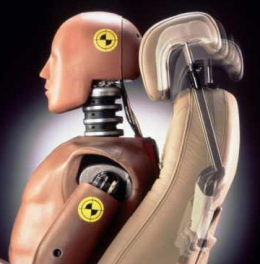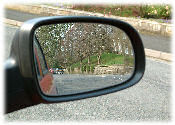Cockpit Drill and Controls: DSSSM
Doors
Explain that the first thing to do upon entering the car is to make sure that it is secure.
Briefly explain that it is a good idea to check that the handbrake is on and then to make sure that the doors are firmly closed.
Explain that the driver is responsible for all doors. Make sure that the driver's door is firmly closed and then point out how the driver can use the passenger door mirror to check the nearside door (the line of the car will be flush).
You might want to mention the rear door of a hatchback, or child locks, but keep the information brief - if the examiner thinks that you are prone to being 'long winded' with your explanations he might lead you on by asking questions about irrelevant details. It's your job to manage your lesson time and keep things on track.
Lock the doors?
A question that often crops up is "Should I lock the doors?" There is no hard and fast rule for this - the answer given on the DriverActive web site is:
"Modern car door locks are designed so that they will not burst open in an accident, whether or not the door is locked? This means that there is no direct safety benefit to be gained by locking the doors, quite the opposite in fact. If the doors are locked it may hinder rescuers or helpers in the event of a car accident.
On the other hand, many drivers feel vulnerable to attack, or robbery, when the car doors are not locked; in these cases, locking the doors may help the driver to relax, and therefore pay more attention to driving."
Seating position and Steering reach
 When you are satisfied that all the doors are securely closed, and that your learner understands how to check this for him/herself, move on to adjustment of the driving seat.
When you are satisfied that all the doors are securely closed, and that your learner understands how to check this for him/herself, move on to adjustment of the driving seat.
Explain where the seat adjustment lever is (or switches in vehicles with electronic seat adjusters).
The seat cushion should be adjusted (that's the bit you sit on) so that all the pedals can be reached. When the clutch is pressed down fully, the left knee should be slightly bent and the seat should support the thigh.
Reaching the steering wheel: The learner should adjust the seat back-rest so that the entire steering wheel rim can be reached by running the hands around it.
Another way to check this would be for them to rest their wrists on the top of the steering wheel with their arms outstretched. Some learners tend to want to sit too close to the wheel, however, you must stress that this leads to discomfort and tension.
Remember to explain how to adjust the head restraints. These should be adjusted so that the supportive portion of the restraint (the bit that the head will hit in an accident) is level with the driver's ears.
The need for a good seat position
It is important for your learners to understand the need for a safe and comfortable driving position and to be able to make the necessary adjustments in order to seat themselves in that position.
A safe position is one where the driver can see clearly out of the vehicle and reach all of the controls in such a way that they can be operated safely.
A comfortable position is one that will prevent excessive fatigue, particularly on long journeys.
It's useful to have a routine that can be learned by rote. This helps to commit the information to memory. For the purposes of this explanation I have used the DSSSM routine, however, there are other methods that can be used. The cockpit drill should take no more than ten minutes to complete.
Seatbelts
Most people who have travelled as passengers in cars will be familiar with seatbelt use; however, they may need information about the basic rules relating to seatbelts. Start with something like "Are you familiar with how to fasten your seatbelt?" the answer will probably be 'Yes' however watch carefully to ensure that the belt is worn correctly.
Explain that in modern cars, seatbelts are provided in both the front and the rear and that although drivers are not responsible in law for non-use of seatbelts by adult passengers, they should always advise the passengers that it is in their own interests to wear a belt.
Mention that the driver, is responsible for belt-wearing by passengers under 14 years of age.
Mirrors
Your learner must learn how to adjust all of the driving mirrors. Although mirrors follow seatbelts in the DSSSM sequence, it may be necessary to adjust the outside mirrors before the seatbelt is fastened in some cars.
Key teaching points:
- Do not touch the glass
- Difference between flat and convex mirrors
- Blind spot (brief info)
- Blind spot mirrors (limitations)
- Adjustment from the normal seating position
- What should be seen in correctly adjusted mirrors
Explain how to adjust the mirrors for maximum rear view from the normal seating position and without leaving sticky fingerprints on the glass. Fingerprints and/or dirty mirrors can have a significant effect on the view in the mirrors, especially after dark.
 Briefly discuss different types of mirror glass (flat and convex) explaining the benefits and drawback of each (involve the learner by asking them to notice the difference in view, rather than just telling them).
Briefly discuss different types of mirror glass (flat and convex) explaining the benefits and drawback of each (involve the learner by asking them to notice the difference in view, rather than just telling them).
Thee picture on the right give an idea of the view from correctly adjusted right door mirror. It is worth asking a couple of similar photos of correctly adjusted mirrors (both left and right) in the vehicle that you will be using for your test to use as teaching aids.
As part of the session on mirror adjustment you should briefly explain the concept of 'blind-spots'; briefly because this would be covered in detail as part of the moving-off and stopping procedure..
Next: Step 3 - Controls example